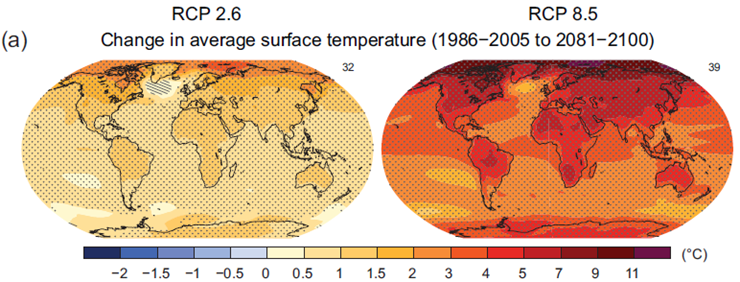References and footnotes
[1] IPCC (2013), 'Summary for Policymakers'. In: Climate Change 2013: The Physical Science Basis. Contribution of Working Group I to the Fifth Assessment Report of the Intergovernmental Panel on Climate Change. Stocker, T.F., Qin, D., Plattner, G-K., Tignor, M., Allen, S. K., Boschung, J., Nauels, A., Xia, Y., Bex, V. and Midgley, P.M. (Eds.) Intergovernmental Panel on Climate Change, Cambridge University Press, Cambridge, UK.
[2] NAS and RS (2014), 'Climate Change, Evidence and Causes', National Academy of Sciences of the United States of America (NAS), Washington, DC 20001, USA, Royal Society (RS), London, UK.
[3] In analogy with IPCC terminology, extremely likely refers to 95–100 % probability, very likely refers to 90–100 % likelihood, and likely refers to 66–100 % likelihood.
[4] Hot days and hot nights occur when maximum and minimum temperatures, respectively, exceed the 90th percentile with respect to the 1961–1990 baseline climate.
[5] Projections of changes in the climate systems as given here utilise a new set of emissions scenarios, the representative concentration pathways (RCPs).[15] These are four scenarios for levels of atmospheric greenhouse gases in the years up to 2100. They vary from a scenario in which greenhouse gas concentrations moderately increase between now and 2100 (RCP 2.6), to scenarios with greater levels of greenhouse gas concentrations (RCP 4.5 and RCP 6); all the way to a scenario in which greenhouse gas concentrations increase very greatly (RCP 8.5 – the scenario to which greenhouse gas emissions are currently heading if no further abatement measures are taken). The RCPs were developed to aid climate modelling, and underpinning the Fifth Assessment Reportof the IPCC. A full description of the comprehensive set of multi-model estimates, as well as further details on the projected trajectories for the various climate components are found in the Fifth Assessment Report of the IPCC.[16] While the focus of this fiche is on describing the potential situation by the end of the 21st century, projections for the coming decades and mid-21st century show similar spatial patterns (i.e. the same parts of the globe being affected by the same effects) but with smaller magnitude.
[6] Foster, G.L., and Rohling, E.J. (2013), 'Relationship between sea level and climate forcing by CO2 on geological timescales', PNAS 110(4), 1209–1214.
[7] Levermann, A., Clark, P.U., Marzeion, B., Milne, G.A., Pollard, D., Radic, V., and Robinson, A. (2013), 'The multimillennial sea-level commitment of global warming', PNAS 110(34), 13745–13750.
[8] Unless stated otherwise, the implications here are based on the findings of the Working Group II contribution to the Fifth Assessment Report of the IPCC.[9]
[9] IPCC (2014), 'Summary for Policymakers'. In: Climate Change 2014: Impacts, Adaptation, and Vulnerability. Contribution of Working Group II to the Fifth Assessment Report of the Intergovernmental Panel on Climate Change. Intergovernmental Panel on Climate Change. Cambridge University Press, Cambridge, UK.
[10] Kraxner, F., Nordström, E-M., Havlík, P., Gusti, M., Mosnier, A., Frank, S., Valin, H., Fritz, S., Fuss, S., Kindermann, G., McCallum, I., Khabarov, N., Böttcher, H., See, L., Aoki, K., Schmid, E., Máthé, L., and Obersteiner, M. (2013), 'Global bioenergy scenarios – future forest development, land-use implications, and trade-offs', Biomass and Bioenergy 57, 86–96.
[11] Hallegatte, S., Green, C., Nicholls, R.J., and Corfee-Morlot, J. (2013), Future flood losses in major coastal cities. Nature Climate Change 3(9), 802–806.
[12] Bloom, A., Burger, M., Kimball, B.A., and Pinter, P.J. (2014), 'Nitrate assimilation is inhibited by elevated CO2 in field-grown wheat', Nature Climate Change 4, 477–480.
[13] Bouzid, M., Colón-González, F.J., Lung, T., Lake, I.R., and Hunter, P.R. (2014), 'Climate change and the emergence of vector-borne diseases in Europe: case study of dengue fever', BMC Public Health 14:781.
[14] EEA (2012), Climate change, impacts and vulnerability in Europe 2012 — an indicator-based report, EEA Report 12/2012, European Environment Agency, Copenhagen, Denmark.
[15] Van Vuuren, D.P., Edmonds, J., Kainuma, M., Riahi, K., Thomson, A., Hibbard, K., Hurtt, G.C., Kram, T., Krey, V., Lamarque, J-F., Masui, T., Meinshausen, M., Nakicenovic, N., Smith, S.J., and Rose, S.K. (2011), 'The representative concentration pathways: an overview', Climatic Change 109(1-2), 5–31.
[16] IPCC (2013), 'Climate Change 2013: The Physical Science Basis'. Contribution of Working Group I to the Fifth Assessment Report of the Intergovernmental Panel on Climate Change.Stocker, T.F., Qin, D., Plattner, G-K., Tignor, M., Allen, S. K., Boschung, J., Nauels, A., Xia, Y., Bex, V. and Midgley, P.M. (Eds.) Intergovernmental Panel on Climate Change, Cambridge University Press, Cambridge, UK.



Document Actions
Share with others